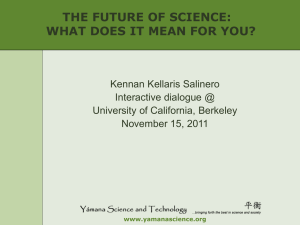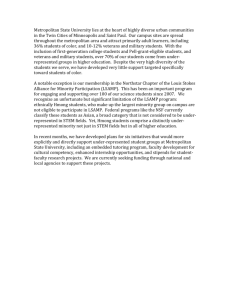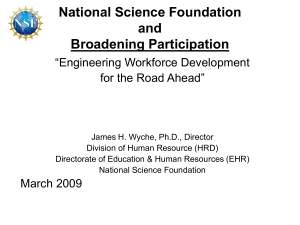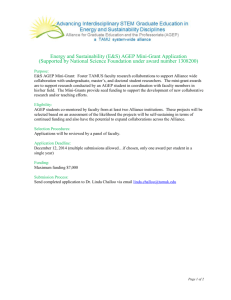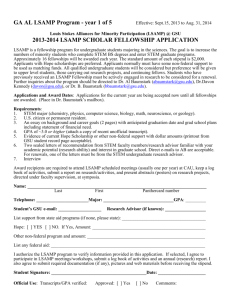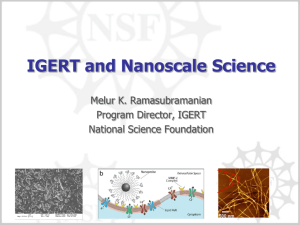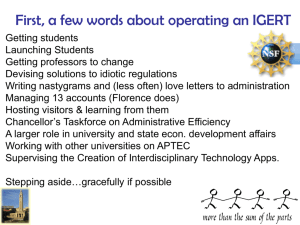View Powerpoint
advertisement
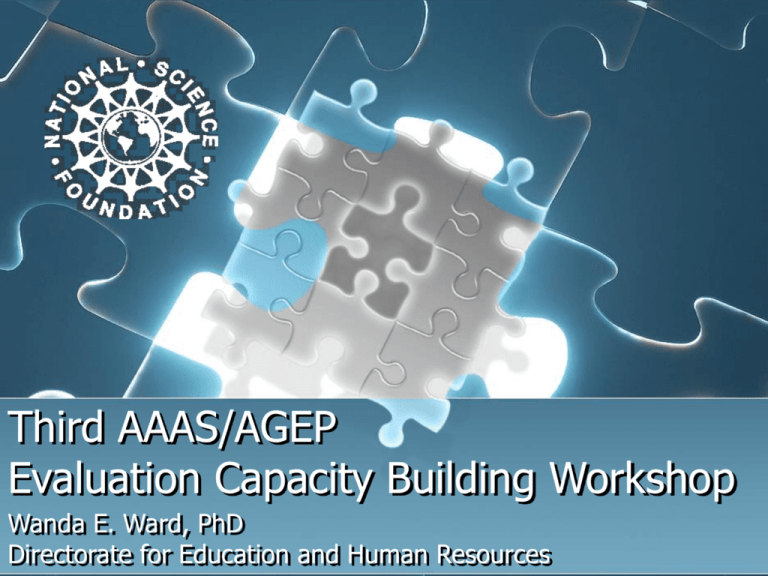
Third AAAS/AGEP Evaluation Capacity Building Workshop Wanda E. Ward, PhD Directorate for Education and Human Resources Overview of Presentation The Role of NSF in STEM Education Drivers EHR’s Shaping the Future Systematic Approach to Evaluation Examples AGEP of EHR Program Evaluations and the Broader Context The Role of NSF in STEM Education To promote a diverse and well-prepared workforce of STEM professionals and educators. To develop the ideas and tools that lead to innovation in STEM education through research and evaluation. To disseminate findings to the S&E community. To promote a public understanding of science. Drivers Shaping the Future Global Competition • Economic • Education • Workforce External Drivers Drivers Shaping the Future Internal Drivers NSF’s NSB Mission 2020 Vision for the NSF EHR’s Mission: To achieve excellence in U.S. science and engineering education at all levels and in all settings, and to ensure the development of a diverse and well-prepared workforce of scientists, engineers, mathematicians, technicians, and educators; and a well-informed citizenry. NSF ‘s Strategic Plan for FY 2006 to FY 2011 Strategic Outcome Goals Discovery Learning Research Infrastructure Stewardship EHR’s Systematic Approach to Evaluation Multi-method approach that includes quantitative and qualitative analyses. An evaluation continuum driven by the program development cycle. Multiple purposes including strategic planning, program improvement, and accountability to advance STEM knowledge. Evaluation Review Criteria DISCOVERY: Does the study advance the field of evaluation? Does it create formative knowledge for program improvement? PROGRAM GOAL/LOGIC: Does the study fully capture the variety of program successes and challenges? EMPIRICAL RIGOR: Are study methods and hypothesis testing appropriate and sufficiently rigorous to meet study aims? EVALUATION STANDARDS: In its design, implementation and reporting, does the study adhere to appropriate standards of utility, feasibility, propriety, and accuracy? Annual Reports Merit Review COV Summative Evaluation GPRA Formative Assessment Year 1 Evaluation Timeline Year 1 Project Level Evaluation Program Monitoring Studies Year 3 Longitudinal Studies Sustainability Studies Year 5 Years 6-7 Years 8-10 Capacity Building of Evaluation Year 3 Year 5 Evaluative Research PART Years 6-7 Years 8-10 Long-Term Impact COV Portfolio Review Examples of EHR Program Evaluations Math and Science Partnership (MSP) Program Advanced Technological Education (ATE) Program Louis Stokes Alliances for Minority Participation (LSAMP) Program Integrative Graduate Education and Research Traineeship (IGERT) Program Math and Science Partnership (MSP) Program A major research and development effort that supports innovative partnerships to improve K-12 student achievement in mathematics and science. An emphasis on K-12 and higher education partnerships. Funded activities: - 36 funded Partnership projects - 12 funded MSP Teacher Institutes - 35+ Research, Evaluation & Technical Assistance (RETA) awards Math and Science Partnership (MSP) Program: Impacts In a first analysis of student data, elementary, middle and high school students showed significant improvements in mathematics proficiency test scores during the 2002-2003 and 2003-2004 school years. During the same period, MSP elementary school students showed significant gains (p<.05) in science proficiency. Math and Science Partnership (MSP) Program: Impacts Growth in the number of participating IHEs 150 IHEs participate in MSP 37% doctoral-granting 26% master's colleges/universities 20% baccalaureate-granting 13% associate-granting institutions Greater commitment and interest among IHEs 2003-2004, 27% of Partnerships reported low levels of commitment or interest among IHE partners 2004-2005, that level dropped to 10% ATE Program Synopsis Education of technicians for the hightechnology fields that drive our nation's economy. Partnerships between academic institutions and employers to improve S&E education at the undergraduate and secondary school levels. ATE portfolio: National and Regional Centers, Resources Centers, model projects, and applied research studies. ATE Program Reach Students: FY 2005, >65,000 students took one or more courses directly impacted by the ATE program with 47,400 of them at 2-year institutions. Instructional: 28,000 faculty and teachers involved in professional development workshops. Partnerships: 7,800 business and industry partnerships with 2,200 educational institutions. Courses: Within these 690 programs, nearly 2,000 courses were developed or improved. Current Evaluation of the ATE Program Program-level formative evaluation by Western Michigan University Program-level analysis of annual and final reports by SRI International Project-level evaluation capacity building workshop Louis Stokes Alliances for Minority Participation (LSAMP) Program The LSAMP program supports sustained and comprehensive approaches to broadening participation at the baccalaureate level. These approaches facilitate the production of students who are well prepared in STEM and motivated to pursue graduate education. LSAMP Evaluation Study • A multi-year evaluation study conducted by The Urban Institute. • Surveyed LSAMP participants who graduated between 1992 and 1997. • 60% response rate • Survey data compared with national data on STEM graduates collected as part of the NSRCG. LSAMP: Education Pipeline Integrative Graduate Education and Research Traineeship (IGERT) Program IGERT has been developed to meet the challenges of educating U.S. Ph.D. scientists and engineers In collaborative, interdisciplinary research in emerging areas across the NSF With technical, professional and personal skills; Catalyzing a cultural change in graduate education; Facilitating diversity in graduate student participation and preparation; and Developing a diverse, globally engaged science and engineering workforce. IGERT: Interdisciplinary Experiences Access to disciplines and expertise outside of home department 93*** 69 Opportunities to study multiple disciplines 86*** 55 Working on a research project involving multiple disciplines 76*** 42 Courses presenting laboratories or research techniques of multiple disciplines 62*** 37 Communicating to people outside your home discipline 50*** 22 Attended professional conference outside home discipline 45*** IGERT 27 Laboratory rotations in multiple disciplines Non-IGERT 41*** 26 0% 10% 20% 30% 40% 50% 60% 70% 80% IGERT N ranges from 303-306. Non-IGERT N ranges from 559-566. Range is due to missing responses. Significance denoted as: *** ( p < .0001) 90% 100% IGERT: Interdisciplinary Experiences Working on joint research projects with individuals outside of home discipline 90*** 78*** 86*** Co-authored proposals with individuals outside home discipline 64*** Co-authored research articles/books with individuals outside home discipline 76*** 60*** 63*** Published research findings in journal outside home discipline 48*** 60*** Presented research findings at a conference outside home discipline Non-IGERT 42*** Team taught courses with faculty members outside home department 28*** 0% Note: IGERT 44*** 10% 20% 30% 40% 50% 60% 70% 80% 90% 100% IGERT N ranges from 344-346. Non-IGERT N ranges from 551-555. Range is due to missing responses. Significance denoted as: * (p<.01) ** (p<.001) *** (p<.0001) AGEP Expanded AGEP SBE Social, Behavioral and Economic Sciences SBE-AGEP Participating Institutions City University of New York (CUNY) Howard University Michigan State University Northwestern University Ohio State University Pennsylvania State University Temple University Texas A&M University Stanford University University of California at Berkeley University of California at Los Angeles University of California at Santa Barbara University of Chicago University of Florida University of Illinois at UrbanaChampaign University of Maryland at College Park University of Miami University of Michigan University of North Carolina at Chapel Hill University of Southern California University of Wisconsin University of Texas at Austin Wayne State University SBES – AGEP Learning Community Northwestern CUNY-MI UC-DIGGS EDGE AC SBES The EHR Portfolio • To prepare the next generation of STEM professionals • To develop a robust research community that can conduct rigorous research and evaluation that will support excellence in STEM education • To increase the technological, scientific and quantitative literacy of all Americans • To broaden participation and close achievement gaps in all STEM fields AGEP and the Broader Context GSE HBCU -UP LSAMP AGEP RDE CREST TCUP Examples of How Evaluation Informs EHR Programming PROGRAM REDIRECTION MGE AGEP Alliances for Graduate Education and the Professoriate CCLI PROGRAM ILI + CCD+ UFE REALIGNMENT OR CONSOLIDATTION Course, Curriculum, and Laboratory Improvement PROGRAM ENHANCEMENT PROGRAM REFINEMENT PGE/PWG GSE Research on Gender in Science and Engineering IGERT QUESTIONS What are the educational/research outcomes for the participating institutions? What is the impact of the program on its participants (e.g. students, faculty and administrators)? How has AGEP increased the knowledge base regarding broadening participation in STEM?
